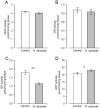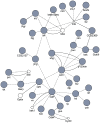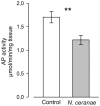Gut pathology and responses to the microsporidium Nosema ceranae in the honey bee Apis mellifera
- PMID: 22623972
- PMCID: PMC3356400
- DOI: 10.1371/journal.pone.0037017
Gut pathology and responses to the microsporidium Nosema ceranae in the honey bee Apis mellifera
Abstract
The microsporidium Nosema ceranae is a newly prevalent parasite of the European honey bee (Apis mellifera). Although this parasite is presently spreading across the world into its novel host, the mechanisms by it which affects the bees and how bees respond are not well understood. We therefore performed an extensive characterization of the parasite effects at the molecular level by using genetic and biochemical tools. The transcriptome modifications at the midgut level were characterized seven days post-infection with tiling microarrays. Then we tested the bee midgut response to infection by measuring activity of antioxidant and detoxification enzymes (superoxide dismutases, glutathione peroxidases, glutathione reductase, and glutathione-S-transferase). At the gene-expression level, the bee midgut responded to N. ceranae infection by an increase in oxidative stress concurrent with the generation of antioxidant enzymes, defense and protective response specifically observed in the gut of mammals and insects. However, at the enzymatic level, the protective response was not confirmed, with only glutathione-S-transferase exhibiting a higher activity in infected bees. The oxidative stress was associated with a higher transcription of sugar transporter in the gut. Finally, a dramatic effect of the microsporidia infection was the inhibition of genes involved in the homeostasis and renewal of intestinal tissues (Wnt signaling pathway), a phenomenon that was confirmed at the histological level. This tissue degeneration and prevention of gut epithelium renewal may explain early bee death. In conclusion, our integrated approach not only gives new insights into the pathological effects of N. ceranae and the bee gut response, but also demonstrate that the honey bee gut is an interesting model system for studying host defense responses.
Conflict of interest statement
Figures





Similar articles
-
Chronic parasitization by Nosema microsporidia causes global expression changes in core nutritional, metabolic and behavioral pathways in honey bee workers (Apis mellifera).BMC Genomics. 2013 Nov 18;14(1):799. doi: 10.1186/1471-2164-14-799. BMC Genomics. 2013. PMID: 24245482 Free PMC article.
-
The pathological effects of a Nosema ceranae infection in the giant honey bee, Apis dorsata Fabricius, 1793.J Invertebr Pathol. 2021 Oct;185:107672. doi: 10.1016/j.jip.2021.107672. Epub 2021 Sep 29. J Invertebr Pathol. 2021. PMID: 34597621
-
Transferrin-mediated iron sequestration suggests a novel therapeutic strategy for controlling Nosema disease in the honey bee, Apis mellifera.PLoS Pathog. 2021 Feb 18;17(2):e1009270. doi: 10.1371/journal.ppat.1009270. eCollection 2021 Feb. PLoS Pathog. 2021. PMID: 33600478 Free PMC article.
-
Nosema ceranae in European honey bees (Apis mellifera).J Invertebr Pathol. 2010 Jan;103 Suppl 1:S73-9. doi: 10.1016/j.jip.2009.06.017. Epub 2009 Nov 11. J Invertebr Pathol. 2010. PMID: 19909977 Review.
-
Effects of the gut parasite Nosema ceranae on honey bee physiology and behavior.Curr Opin Insect Sci. 2018 Apr;26:149-154. doi: 10.1016/j.cois.2018.02.017. Epub 2018 Mar 2. Curr Opin Insect Sci. 2018. PMID: 29764655 Review.
Cited by
-
Effects of Plant-Based Supplement on Oxidative Stress of Honey Bees (Apis mellifera) Infected with Nosema ceranae.Animals (Basel). 2023 Nov 16;13(22):3543. doi: 10.3390/ani13223543. Animals (Basel). 2023. PMID: 38003159 Free PMC article.
-
Nosema apis and N. ceranae Infection in Honey bees: A Model for Host-Pathogen Interactions in Insects.Exp Suppl. 2022;114:153-177. doi: 10.1007/978-3-030-93306-7_7. Exp Suppl. 2022. PMID: 35544003
-
The Honeybee Gut Microbiota Is Altered after Chronic Exposure to Different Families of Insecticides and Infection by Nosema ceranae.Microbes Environ. 2019 Sep 25;34(3):226-233. doi: 10.1264/jsme2.ME18169. Epub 2019 Aug 3. Microbes Environ. 2019. PMID: 31378758 Free PMC article.
-
Chronic parasitization by Nosema microsporidia causes global expression changes in core nutritional, metabolic and behavioral pathways in honey bee workers (Apis mellifera).BMC Genomics. 2013 Nov 18;14(1):799. doi: 10.1186/1471-2164-14-799. BMC Genomics. 2013. PMID: 24245482 Free PMC article.
-
Honeybee product therapeutic as stem cells homing for ovary failure.Vet World. 2016 Nov;9(11):1324-1330. doi: 10.14202/vetworld.2016.1324-1330. Epub 2016 Nov 29. Vet World. 2016. PMID: 27956789 Free PMC article.
References
-
- Becnel JJ, Andreadis TG. Microsporidia in insect. In: Wittner M, Weiss LM, editors. The Microsporidia and Microsporidiosis. Washington, DC: ASM Press; 1999. pp. 447–501.
-
- Higes M, Garcia-Palencia P, Martin-Hernandez R, Meana A. Experimental infection of Apis mellifera honeybees with Nosema ceranae (Microsporidia). J Invertebr Pathol. 2007;94:211–217. - PubMed
-
- Zander E. Tierische Parasiten als Krankenheitserreger bei der Biene. Münchener Bienenzeitung. 1909;31:196–204.
-
- Fries I, Feng F, Da Silva A, Slemeda SB, Pieniazek NJ. Nosema ceranae n. sp. (Microspora, Nosematidae), morphological and molecular characterization of a microsporidian parasite of the Asian honey bee Apis cerana (Hymenoptera, Apidae). Eur J Protistol. 1996;32:356–365.
-
- Fries I. Nosema ceranae in European honey bees (Apis mellifera). J Invertebr Pathol. 2010;103:S73–S79. - PubMed
Publication types
MeSH terms
Substances
LinkOut - more resources
Full Text Sources
Molecular Biology Databases

